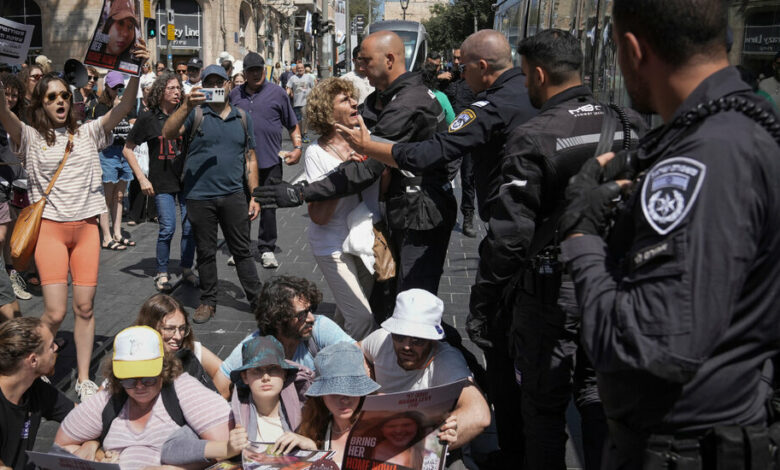After 9 months of war, Israelis call for ceasefire deal and elections

Israelis on Sunday marked nine months since Hamas’ devastating October 7 attack and the start of the ensuing war in Gaza with a nationwide day of anti-government protests in a moment seen by many here as a turning point in the conflict.
Protesters were calling primarily for a ceasefire with Hamas, the return of hostages from captivity, and new elections in Israel. They blocked morning traffic at several major city intersections and on highways across the country. By lunchtime, much of central Tel Aviv was blocked in one of the largest protests in months.
Some progress has been made in recent days in resuming negotiations on a preliminary agreement after weeks of deadlock, amid continued fighting in Gaza, where an Israeli attack took place near a UN school on Saturday, and on Israel’s northern border with Lebanon.
Many Israelis, including family members of hostages, fear that the ceasefire efforts could be torpedoed not only by Hamas but also by Israeli Prime Minister Benjamin Netanyahu, who they say values the survival of his government over a deal that could bring it down.
The leaders of two ultranationalist parties that are key elements of Netanyahu’s coalition have threatened to bring down the government if the prime minister agrees to a deal before Hamas is completely destroyed. Many officials and experts see this as an unachievable goal.
The far-right parties in the ruling coalition “don’t want a deal,” Shikma Bressler, a leader of the protest, said in a social media post. after early on Sunday, adding: “They need Armageddon.”
“And Bibi?” Ms. Bressler added, referring to Mr. Netanyahu by his nickname. “He needs war so there are no elections.”
Israeli aircraft on Saturday struck the area of a United Nations school in Nuseirat, central Gaza, where the Israeli military said Palestinian militants were operating from several buildings. At least 16 people were killed and dozens wounded in the attack, according to the Gaza Health Ministry, which does not distinguish between civilians and fighters. More than 38,000 Palestinians have been killed in Gaza so far, according to local health officials.
The school had become a shelter for displaced people seeking safety, the ministry added. Hamas in a statement called the strike a “mass murder.” The Israeli military said it had taken measures to prevent civilian casualties in the strike and blamed Hamas for operating from areas filled with Gaza civilians.
On Sunday, the Israeli military said it was continuing operations in Rafah, Gaza’s southernmost town, and in Shajaiye, an area east of Gaza City, in the north. The air force also struck the town hall in Khan Younis, a major southern town from which Israeli ground forces withdrew in April.
Hamas used the building, the army said, for military activities. Before the attack, the army said, the civilian population was evacuated from the area.
Israel’s northern border also remained unsettled on Sunday, a day after Israeli aircraft carried out a deadly strike on a member of Lebanon’s Hezbollah organization in the Baalbek area, deep inside Lebanese territory about 40 miles northeast of Beirut.
Israel identified the target as Meitham Mustafa Altaar and described him as a senior operative in Hezbollah’s Air Defense Unit who has been involved in several attacks on Israel.
A barrage of about 20 rockets was fired from Lebanon into Israel on Sunday, deeper than most previous salvos in months of tit-for-tat cross-border clashes. One man was seriously wounded by shrapnel, Israeli emergency services said.
At a protest held in Tel Aviv on Saturday night calling for the release of the hostages, a weekly occurrence, Einav Zangauker, whose son Matan is being held hostage in Gaza, said of the renewed ceasefire talks: “For the first time in months we feel hope.”
But she added: “Netanyahu, we have seen how you have torpedoed deals time and again at the moment of truth. Our hearts were broken every time. Don’t you dare break our hearts again! It is your duty to bring back all the citizens you have abandoned.”
Many Israelis are angry about Mr. Netanyahu’s refusal so far to take any personal responsibility for the Israeli intelligence and policy failures that led to the Oct. 7 terrorist attack, which Israeli authorities say killed 1,200 people and brought some 250 others to Gaza. Of the 120 hostages still in Gaza, at least a third are believed dead, officials say.
Sunday’s protests, which organizers called a national “Day of Unrest,” began at 6:29 a.m. — the time the Hamas-led attack began on Oct. 7 — with “wake-up calls” outside the homes of several lawmakers and ministers, including Defense Minister Yoav Gallant.
Several tech companies announced they would give their staff time off to participate in the protests, which were expected to escalate into large gatherings in Tel Aviv and Jerusalem later in the day. Sunday is a workday for most Israelis.
Despite recent progress in indirect contacts between Israel and Hamas, through American and Arab mediators, there are still sticking points and a ceasefire is not expected in the near future.
The talks are based on a three-phase framework first presented by President Biden in late May and later approved by the United Nations Security Council.
Both sides have agreed on the broad outlines of a deal that would include an initial six-week ceasefire and the release of the most vulnerable civilian hostages in exchange for Palestinian prisoners. But Hamas wants guarantees that Israel will not restart the war after some hostages return home. Israel says it needs the option to resume hostilities and will not effectively commit to a permanent ceasefire from the outset.
Gabby Sobelman And Myra Nieuwenhuis contributed to the reporting.




